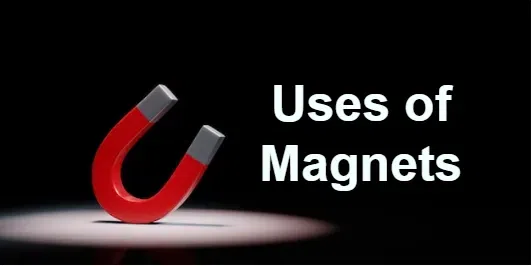Uses of Magnets
Last Updated :
05 Apr, 2024
Magnets are materials that have magnetic properties and they attract and repel other magnetic material. Magnets have various uses in our life, such as they are used in motors, inverters, and other electrical equipment, they are used for medical purposes, have industrial applications and others.

In this article we will learn about, what are magnets, uses and applications of magnets and others in detail.
What are Magnets?
Magnets are objects that produce a magnetic field, which exerts attractive or repulsive forces on other materials having magnetic properties. They are typically made of materials like iron, nickel, cobalt, or certain alloys. Magnets have two poles, commonly referred to as the north and south poles.
How are Magnets Useful?
Magnets are incredibly useful in various aspects of everyday life. Magnets are essential for generating electricity in motors and generators, enabling various applications from household appliances to industrial machinery and its applications are added below in the article:
Applications and Uses of Magnets
Various uses of magnets in real life situations are:
In Magnetic Resonance Imaging (MRI)
Strong magnets are used in MRI machines to provide precise images of internal body structures for diagnosis purposes. Using a strong magnetic field to align hydrogen atoms within the body and then using radio waves to disturb this alignment, magnetic resonance imaging (MRI) scanners generate high-definition images that aid medical professionals in identifying anomalies like tumors, injuries, and illnesses.
MRI is utilized for:
- Detailed soft tissue imaging.
- Neurological conditions like multiple sclerosis.
- Cardiac assessment, including heart function.
- Visualizing blood vessels (angiography).
- Diagnosing musculoskeletal issues.
- Cancer detection and staging in various organs.
In Generators and Electric Motors
Magnets are used in electric motors and generators to transform electrical energy into mechanical motion or the other way around. These devices’ permanent magnets or electromagnets produce magnetic fields that interact with conductive materials to cause motors to rotate or generators to produce electricity. Applications include everything from electric vehicle propulsion and home appliance powering to wind turbine electricity generation.
- Power generation (hydroelectric, wind turbines).
- Transportation (electric vehicles).
- Industrial machinery (conveyors, pumps).
- Renewable energy (wind, solar).
- Home appliances (refrigerators, washing machines).
- Aerospace systems (landing gear, controls).
In Magnetic Levitation (Maglev) Trains
Trains using magnetic levitation, or “Maglev” technology, use strong electromagnets to lift train cars above the tracks, removing resistance and enabling fast movement. Compared to conventional rail systems, Maglev technology offers smoother rides, faster speeds, and less maintenance because it uses magnetic repulsion to lift and propel the train. Two such examples are the JR-Maglev in Japan and the Shanghai Maglev Train in China.
Maglev trains utilize magnetic levitation to:
- Achieve high speeds with minimal friction.
- Improve efficiency and reduce energy consumption.
- Provide smooth and quiet transportation.
- Enhance safety by eliminating derailment risks.
- Reduce maintenance needs compared to traditional rail systems.
In Magnetic Data Storage
Hard disk drives (HDDs) and magnetic tape are examples of magnetic storage devices that use tiny magnetic regions to store digital data. Information can be encoded as binary digits (0s and 1s) that can be long-term stored and retrieved in computers, servers, and backup systems by altering the magnetic orientation of these regions.
Magnetic fields are used in magnetic data storage to:
- Organize digital data on magnetic media.
- Turn on magnetic tapes and hard disk drives (HDDs) for high-density storage.
- Maintain the integrity of your data for a long time.
- Enable quick access to and retrieval of information that has been stored.
Magnetic Sensors in Electronics
Magnetic sensors, such as magnet resistive and Hall effect sensors, are widely used in electronic devices for position sensing, proximity detection, and current measurement. By detecting changes in magnetic fields and converting them into electrical signals, they enable applications such as automotive speed sensors, contactless switches in appliances, and smartphone compasses. Magnetic sensors in electronics are generally used for:
- Turn on the navigation and compasses on cellphones.
- Streamline position sensing for automotive uses, such as ABS brakes.
- For exact positioning, and to enable feedback control in robots and motors.
Conclusion
Thus, it is evident that magnets play a fundamental role in modern technology and industry, offering a wide range of applications that enhance efficiency, convenience, and functionality in numerous fields.
FAQs on Applications of Magnets
What are 5 uses of magnets?
Some common uses of magnets are:
- Magnets are used in magnetic compass, door bells, refrigerators.
- Magnets are used in dynamos, motors, loudspeakers, microphones etc.
- Magnets are used in computers.
- Magnets are used in toys to give magic effect.
- Magnets are used for medical purposes.
How is magnetic fields get created?
Magnetic fields are created by moving electric charges. When electric charges, such as electrons, move through a conductor, they generate a magnetic field around them.
Is Earth a magnet?
Yes, Earth behaves like a giant magnet due to the movement of molten iron and nickel in its outer core.
What are Permanent Magnets?
Permanent magnets are materials that retain their magnetization once magnetized, unlike temporary magnets. They are typically made from materials like iron, nickel, cobalt, or their alloys.
What are Temporary Magnets?
Temporary magnets are materials that only exhibit magnetic properties when subjected to an external magnetic field.
How do electromagnets and permanent magnets differ from one another?
While electromagnets need an electric current to create a magnetic field, permanent magnets maintain their magnetism without the need for an external power source.
Can a magnet lose its magnetic properties with time?
Yes, a variety of conditions, including exposure to extreme heat, physical harm, and demagnetizing fields, can cause a magnet to gradually lose its magnetic properties.
Share your thoughts in the comments
Please Login to comment...